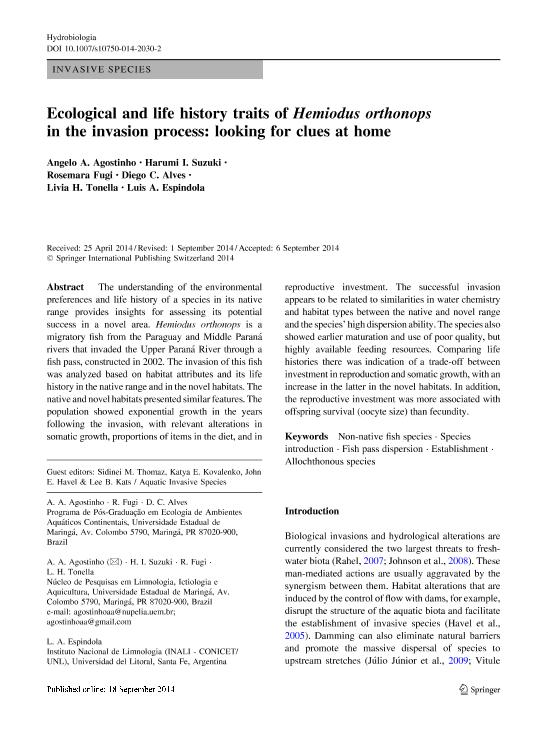Mostrar el registro sencillo del ítem
dc.contributor.author
Agostinho, Angelo A.
dc.contributor.author
Suzuki, Harumi I.
dc.contributor.author
Fugi, Rosemara
dc.contributor.author
Alves, Diego C.
dc.contributor.author
Tonella, Livia H.
dc.contributor.author
Espínola, Luis Alberto

dc.date.available
2018-03-07T21:29:32Z
dc.date.issued
2015-03
dc.identifier.citation
Agostinho, Angelo A.; Suzuki, Harumi I.; Fugi, Rosemara; Alves, Diego C.; Tonella, Livia H.; et al.; Ecological and life history traits of Hemiodus orthonops in the invasion process: looking for clues at home; Springer; Hydrobiologia; 746; 1; 3-2015; 415-430
dc.identifier.issn
0018-8158
dc.identifier.uri
http://hdl.handle.net/11336/38234
dc.description.abstract
The understanding of the environmental preferences and life history of a species in its native range provides insights for assessing its potential success in a novel area. Hemiodus orthonops is a migratory fish from the Paraguay and Middle Paraná rivers that invaded the Upper Paraná River through a fish pass, constructed in 2002. The invasion of this fish was analyzed based on habitat attributes and its life history in the native range and in the novel habitats. The native and novel habitats presented similar features. The population showed exponential growth in the years following the invasion, with relevant alterations in somatic growth, proportions of items in the diet, and in reproductive investment. The successful invasion appears to be related to similarities in water chemistry and habitat types between the native and novel range and the species' high dispersion ability. The species also showed earlier maturation and use of poor quality, but highly available feeding resources. Comparing life histories there was indication of a trade-off between investment in reproduction and somatic growth, with an increase in the latter in the novel habitats. In addition, the reproductive investment was more associated with offspring survival (oocyte size) than fecundity.
dc.format
application/pdf
dc.language.iso
eng
dc.publisher
Springer

dc.rights
info:eu-repo/semantics/openAccess
dc.rights.uri
https://creativecommons.org/licenses/by-nc-sa/2.5/ar/
dc.subject
Allochthonous Species
dc.subject
Establishment
dc.subject
Fish Pass Dispersion
dc.subject
Non-Native Fish Species
dc.subject
Species Introduction
dc.subject.classification
Otras Ciencias Biológicas

dc.subject.classification
Ciencias Biológicas

dc.subject.classification
CIENCIAS NATURALES Y EXACTAS

dc.title
Ecological and life history traits of Hemiodus orthonops in the invasion process: looking for clues at home
dc.type
info:eu-repo/semantics/article
dc.type
info:ar-repo/semantics/artículo
dc.type
info:eu-repo/semantics/publishedVersion
dc.date.updated
2018-03-06T17:43:23Z
dc.journal.volume
746
dc.journal.number
1
dc.journal.pagination
415-430
dc.journal.pais
Alemania

dc.journal.ciudad
Berlin
dc.description.fil
Fil: Agostinho, Angelo A.. Universidade Estadual de Maringá; Brasil
dc.description.fil
Fil: Suzuki, Harumi I.. Universidade Estadual de Maringá; Brasil
dc.description.fil
Fil: Fugi, Rosemara. Universidade Estadual de Maringá; Brasil
dc.description.fil
Fil: Alves, Diego C.. Universidade Estadual de Maringá; Brasil
dc.description.fil
Fil: Tonella, Livia H.. Universidade Estadual de Maringá; Brasil
dc.description.fil
Fil: Espínola, Luis Alberto. Consejo Nacional de Investigaciones Científicas y Técnicas. Centro Científico Tecnológico Conicet - Santa Fe. Instituto Nacional de Limnología. Universidad Nacional del Litoral. Instituto Nacional de Limnología; Argentina
dc.journal.title
Hydrobiologia

dc.relation.alternativeid
info:eu-repo/semantics/altIdentifier/doi/http://dx.doi.org/10.1007/s10750-014-2030-2
dc.relation.alternativeid
info:eu-repo/semantics/altIdentifier/url/https://link.springer.com/article/10.1007%2Fs10750-014-2030-2
Archivos asociados
